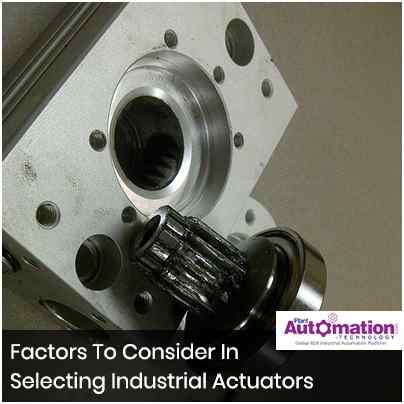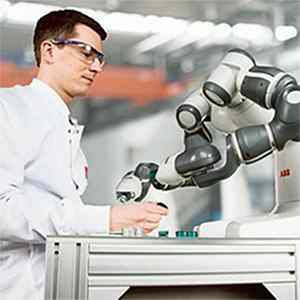5 Major Factors To Consider In Selecting Industrial Actuators

The rising demand for industrial actuators is driving the market. Owing to their ability to provide high precision and control compared with other industrial actuators, they are gaining popularity in industries. The industrial actuators eliminate fluid leaks and high noise creation. These actuators are environmentally friendly, more energy-efficient, and incur low maintenance. Moreover, as the industrial electric actuators can be networked and reprogramed quickly, they are a natural fit for automation and IoT applications. Hence, it has increased its use in applications such as robotic dispensing and robotic spot welding.
It is predicted that the industrial actuators market in 2019 is estimated to be USD 49.2 billion and is projected to reach 74.5 billion by 2024, at a CAGR of 8.6% from 2019 to 2024.
These days industries are heavily dependent on automated machinery or processes than other manual or mechanized systems. The automated equipment apart from providing superior performance helps minimize unsafe assembly and industrial processes requiring human intervention. With the increasing utilization of automated machinery or systems, there has also been a rise in the demand for industrial actuators, which play a vital role in the functioning of automated devices. There are several different types of industrial actuators available with different stroke, speed, shape, capacity, and size to best suit the application or to make the best actuation possible. The industrial actuators which are responsible for moving, controlling, or positioning a mechanism or system make the working of automated equipment seamless and quite easy.
There are a few factors to consider in the selection of industrial actuators to obtain the most efficient automation system.
Selection Of Industrial Actuators
A) Stroke Length
Selecting the proper stroke length is one of the most important steps in finding that perfect actuator. Usually, the customers know what type of unit they want and how much force they need when it comes to the stroke size. So, before going ahead we must emphasize more on how to select a stroke size and how it will affect the dimensions of the actuator. When selecting the stroke of your industrial actuators, you need to take into account the dimensions of the actuator, specifically the mounting hole to mounting hole length and the end to end length. Once you get these dimensions, it will be easier in selecting the stroke and determining the overall length of the unit. Each type of industrial actuators has its range limitations, typically 50-250mm.
B) Mounting Brackets
The mounting brackets have been specifically designed for linear actuators wherein customers can select from a number of different options. The brackets can be installed along the stroke of some actuators, and some that provide a sturdier choice for those high force applications. Every industrial actuator comes with two mounting holes - one on the bottom of the actuator and one on the top. This makes it easy to mount the actuators and every bracket comes with all necessary hardware to mount properly.
As the brackets give you a complete 180° of rotation on either end of the actuator, so it's easy to mount at almost any angle you need to. Moreover, every bracket is designed to fit a certain actuator, so it takes the stress out of selecting one. You just need to find the actuator you have and then match it with the correct bracket. Customization and pricing are the two major factors in choosing a bracket for the industrial actuators.
C) Connections and Cables
It's a very simple and easy process to connect a linear actuator to a control. Few of the actuators have 4-pin connectors. So, it's simply a matter of plugging everything in and going on your way. But, you need to use a slightly different method if you have an actuator that doesn't have a 4-pin actuator. Generally, most of the actuators do not come with a 4-pin connector. And if yours does not have a connector, you'll need to purchase an additional connector that is available in 6-foot and 2-foot lengths.
In the case where you have a connector, then you should have an actuator with exposed wires at the end. Strip back the wiring until you have enough and if you need more room to connect your 4-pin connector. Now, you shall be able to connect your linear actuators to the 4-pin connector. Twist the connections together and cover them up with electrical tape. The last thing you could do is just plug in your 4-pin connector, plug in your control box to the power supply and test it out.
D) Feedback and/or Limit Switches
Due to the ease of installation, rugged design, and harsh environments, the limit switches are suitable for use in a wide range of applications and harsh environments on the factory floor. Typically, the limit switches are used in physical contact applications that cause wear and tear on the switch actuator and electrical contacts. So, exceeding two operations per second should be avoided.
When selecting a limit switch, consider the application and actuation method first, as they are often the clearer determining factors. Integrating limit switches is the most common way to avoid running the actuators to the end of the stroke. A limit switch is nothing but a circuit that halts the motor at the desired or programmed stroke position and only allows it to start in the opposing direction. This implies that the actuator will avoid the mechanical stress that would occur if it ran into a mechanical or physical stop. There are some key considerations when using limit switches. The selection criteria for limit switches are usually the - repeatability, force to operate, contact configuration, actuation method, environment requirements, and travel to operate and reset.
E) Force
The force refers to the torque requirement of the valve. This implies the amount of force required to move the valve from the open position to the closed. The force required would be a linear push-and-pull force in a sliding stem valve, whereas multi-turn or part-turn valves require a rotary force. A number of factors such as - minimum and maximum supply pressure, actuator type, fail mode, valve torque are required to determine the amount of force required.
Apart from these, there are other considerations like the media temperature, size and design of the valve, stem packing friction, differential pressure across the valve, and the mechanical characteristics of both the valve stem and valve. If your application involves a force or an abrupt stop, you may need to consider the impact force to properly mount and insulate your system. Understanding the velocity and force of your application is critical, because it can affect the selection of other parts of your linear actuator such as the nuts, bal screws, and motors. The impact force will help you determine the inertial forces for cushioning, whereas the total force will help you understand the desired motion you are attempting to generate and help select the right size motor and actuator.










